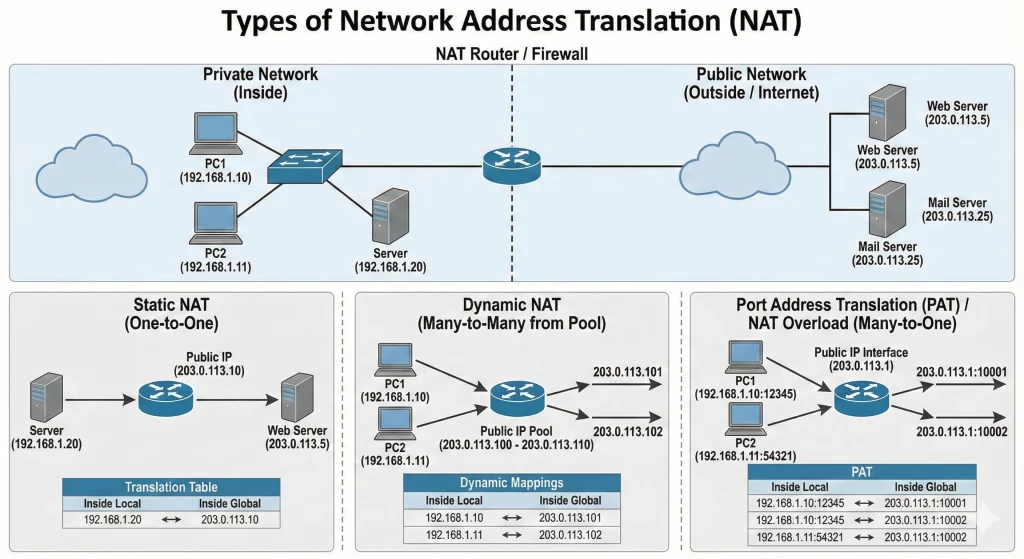Types of Network Address Translation

Network Address Translation (NAT) is a technique used in networking to modify the source or destination IP addresses of packets as they traverse a routing device, such as a router or firewall. This process enables multiple devices within a private network to access external networks, like the internet, using a single public IP address, thereby conserving IP address space and enhancing security.
Table of Contents
ToggleTypes of Network Address Translation:

- Definition: Maps a private internal IP address to a public external IP address on a one-to-one basis.
- Use Case: Suitable for hosting services within a private network that need to be accessible from external networks, such as web servers or email servers.
- Example: An internal server with IP address 192.168.1.10 is always accessible from the internet via the public IP address 203.0.113.5.
- Definition: Maps a private internal IP address to a public external IP address from a pool of available public addresses.
- Use Case: Ideal for networks where internal devices require occasional access to external networks, but not all devices need a persistent public IP address.
- Example: A company assigns public IP addresses from a pool to internal devices as they initiate connections to the internet, ensuring efficient use of limited public IP addresses.
- Definition: Maps multiple private internal IP addresses to a single public IP address or a few addresses by differentiating the connections based on port numbers.
- Use Case: Commonly used in home networks and small businesses where numerous devices share a single public IP address to access external networks.
- Example: Multiple devices within a home network access the internet using the public IP address 198.51.100.2, with each connection identified by unique port numbers.
Additional NAT Variants:
Destination NAT (DNAT):
- Definition: Modifies the destination IP address of incoming packets to direct them to specific internal servers.
- Use Case: Useful for exposing internal services to external users, such as hosting a public-facing website.
- Example: Incoming traffic to the public IP address 203.0.113.5 on port 80 is forwarded to an internal web server with IP address 192.168.1.20.
Bidirectional NAT:
- Definition: Simultaneously translates both the source and destination IP addresses of packets.
- Use Case: Applicable in scenarios where both internal and external users need to access services within a private network.
- Example: Facilitates communication between internal users and external clients by appropriately translating both source and destination addresses.
Considerations When Choosing a NAT Type:
- Network Size and Structure: Determine whether your network requires one-to-one mappings (static NAT) or many-to-one mappings (PAT) based on the number of devices and their access needs.
- Security Requirements: NAT can provide a basic level of security by obscuring internal IP addresses, but additional security measures may be necessary for sensitive applications.
- Application Compatibility: Some applications may not function correctly with certain types of NAT due to the way they handle IP address and port information.
Understanding the different types of NAT and their appropriate applications is essential for effective network design, efficient IP address management, and ensuring seamless connectivity for both internal and external communications.
Trusted IPv4 Leasing for Business Growth
Get enterprise-grade IPv4 space quickly, with seamless deployment and end-to-end management.
Related Blogs
Standfirst — As IPv4 remains scarce, some nations show particularly strong demand for legacy IP resources. Knowing which helps guide Read more
A clear comprehension of the discrepancies between IP reputation and IP risk score constitutes a critical prerequisite for effective cybersecurity Read more
A clear comprehension of the discrepancies between IP reputation and IP risk score constitutes a critical prerequisite for effective cybersecurity Read more
Standfirst — As IPv4 remains scarce, some nations show particularly strong demand for legacy IP resources. Knowing which helps guide Read more
A clear comprehension of the discrepancies between IP reputation and IP risk score constitutes a critical prerequisite for effective cybersecurity Read more
A clear comprehension of the discrepancies between IP reputation and IP risk score constitutes a critical prerequisite for effective cybersecurity Read more



